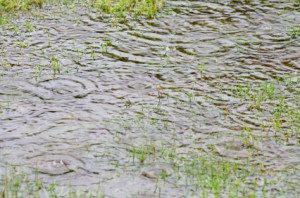Texas weather is the reason that many of us live here. We like warmer winters and mild climates. However, as many Texas homeowners know, rainfall can be unpredictable for us. We can have periods of drought followed by periods of frequent rain. During these rainy stretches, drainage problems can become apparent and when they do, it may indicate a potential foundation risk that needs your attention. Drainage problems and your foundation are important topics.
 If your home was built properly, things such as drainage and the slope of your landscape were taken into account. Water should be carried away from your home so that it doesn’t collect near your home’s foundation. However, all too often home builders fail to take into account the full range of drainage issues when they build the home. That can result in water that puddles or “ponds” near your foundation. Too much water near the foundation can lead to an expansion of the soil underneath your home as the excess water is soaked up. When this happens repeatedly, it can cause Upheaval – a problem where a portion of the foundation is pushed up above the original elevation. Upheaval can cause significant problems for your home such as cracks on interior or exterior walls, or doors and windows that do not open and close properly.
If your home was built properly, things such as drainage and the slope of your landscape were taken into account. Water should be carried away from your home so that it doesn’t collect near your home’s foundation. However, all too often home builders fail to take into account the full range of drainage issues when they build the home. That can result in water that puddles or “ponds” near your foundation. Too much water near the foundation can lead to an expansion of the soil underneath your home as the excess water is soaked up. When this happens repeatedly, it can cause Upheaval – a problem where a portion of the foundation is pushed up above the original elevation. Upheaval can cause significant problems for your home such as cracks on interior or exterior walls, or doors and windows that do not open and close properly.
Drainage problems can also cause issues if too much water sits near your foundation and obstructs the weep holes built into your exterior walls. Exterior bricks absorb rain and moisture. Temperature differences between the interior sheet rock of your home and moisture in your exterior bricks creates condensation. Weep holes are designed to prevent or remove this condensation. However, if your weep holes are obstructed, mold and mildew can develop, and this moist environment might encourage pests to take up residence.
Any time there is a period of extended rainfall, it’s a good idea to survey your landscape. Are there any areas near your home’s foundation that are ponding? How long is it taking water near the exterior walls of your home to run off or evaporate? You should also take note of your landscaping. If the rainfall has caused your garden beds or soil to cover weep holes or rise above the level of your foundation, then your soil may not be draining efficiently.
Drainage problems need to be corrected or you can put your foundation at risk. Expansion and shrinkage of the soil under our home’s foundation is the single biggest cause of foundation damage. If the exterior of your home is not draining properly, this process of expansion and shrinkage will most likely occur, putting a strain on your foundation.
Many homes do have adequate drainage, but if you have concerns, it is always better to have a professional examine your foundation. Solutions may be as simple as roof gutters or diversion channels, but having a foundation inspection is the best starting point.
At Dawson Foundation Repair, we offer free inspections for home owners whose homes are not involved in real estate transactions. If you are seeking an inspection for that reason, we suggest you seek the opinion of a Structural Engineer with experience in residential slab foundations. However, if you have concerns about the proper drainage of your home, we are here to help you. We can handle drainage problems and your foundation. Call us for a free inspection and assessment of your home’s foundation.
